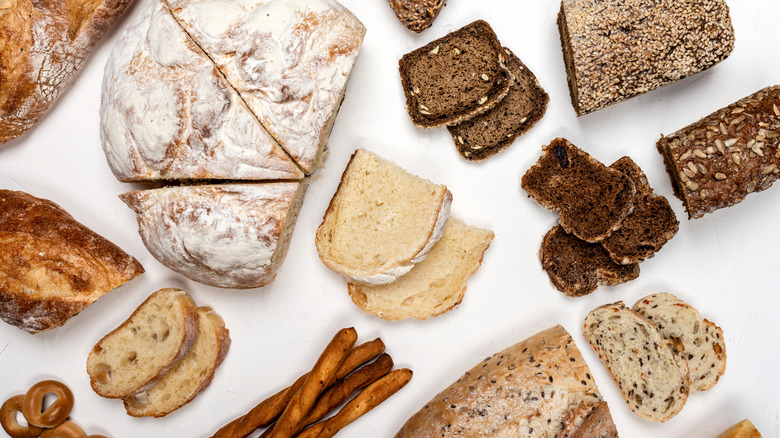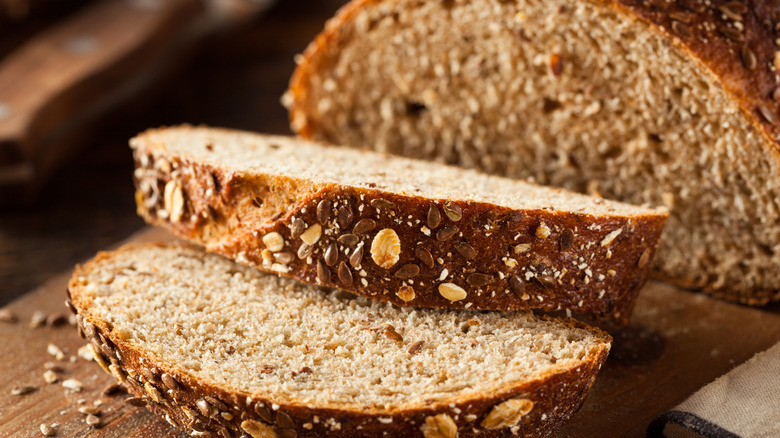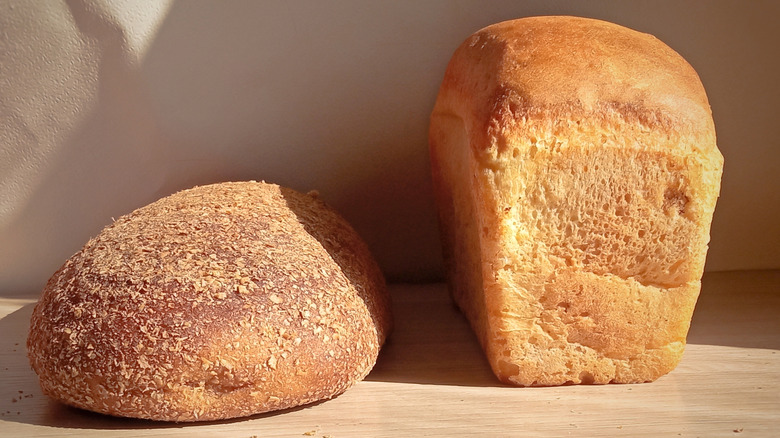Whole-Wheat And White Whole-Wheat Flour: What's The Difference?
We may receive a commission on purchases made from links.
If you're debating on which flour to use when baking, you'll need to know how it interacts in a recipe. The texture, structure, flavors, and overall outcome of your baked goods depend on it. When you understand how flour is manufactured from manipulating different kinds of wheat, the magical chemical reactions of baking are yours to play with.
A quick note about wheat's composition: each kernel is made up of layers called the endosperm, germ, and bran. White flour gets its color and smoothness when the outer germ and bran are stripped, leaving behind only the endosperm. Whole-wheat and white whole-wheat flour keep their three grain components (and nutritional benefits), but their texture, appearance, and actual type of grain is different.
White whole-wheat flour's name can also be a bit confusing, as it sounds like the traditional white flour. Both wheat types have their ups and downs when it comes to baking, but they are nutritionally similar and offer a healthier alternative to the "refined" flour types. We'll break down how each type of flour is made, and what recipes they're best suited for.
When to use whole wheat flour
Whole-wheat flour is commonly milled from hard red wheat, which gives it a darker color than white flour. Red wheat also has a coarser bran (the outer skin), giving the flour an earthier, nuttier taste. While you wouldn't necessarily use this in a wedding cake, it's great for homemade English muffins or banana bread. If you'd like your baked good to be a bit heavier and have a little extra nutrition, go with the whole wheat flour. You can't, however, just swap it out for any old recipe, so be careful when you substitute. The literal king of flours, King Arthur Baking Company, suggests to substitute whole wheat for white flour by volume, not by weight.
Whole wheat flour is really the "OG" of baking, if only because there were no other options. All flours were whole wheat back then, and people ate that way for thousands of years until the Industrial Revolution in the 19th century introduced new milling techniques. Suddenly, white flour was the hottest thing around, praised for its longer shelf life and refined texture. Thanks to hippies and the health food movement of the 1960s and '70s, wheat flour has since come back into fashion and stayed a traditional, nutritional flour friend.
When to use white whole-wheat flour
The name itself is confusing, but this flour is just another kind of whole wheat. Instead of coming from the traditional hard red winter wheat, it comes from, natch, white wheat. This lends to an overall milder flavor, which, combined with the lighter color makes it an even better substitute for refined flour. It's nutritionally the same as whole wheat flour, but with a lighter, sweeter taste — perfect for more delicate recipes like waffles or crepes.
Where did this magical, seemingly do-it-all wheat come from? Straight from the "Wheat State," of course. Kansas State began cross-breeding the strain back in the 1970s, and early crops were made mainstream by the American White Wheat Producers Association. Early adopters like the aforementioned King Arthur and Hodgson Mill began putting the golden flour on shelves as early as the '90s, but interestingly enough, King Arthur rebranded the flour with a new name in the summer of 2024. Now known as Golden Whole Wheat, the baking company explained that "Changing the name helps communicate that this flour is not a blend, but rather milled from 100% hard white wheat — a lighter and more golden-colored grain than traditional red wheat, which yields a milder-tasting whole wheat flour with all the nutritional benefits of whole wheat."
When it comes to baking, texture and consistency are everything, so it's helpful to know how each flour interacts in recipes. Now that you're an expert on wheat types, you can exploit and enjoy all the powers of flour.


